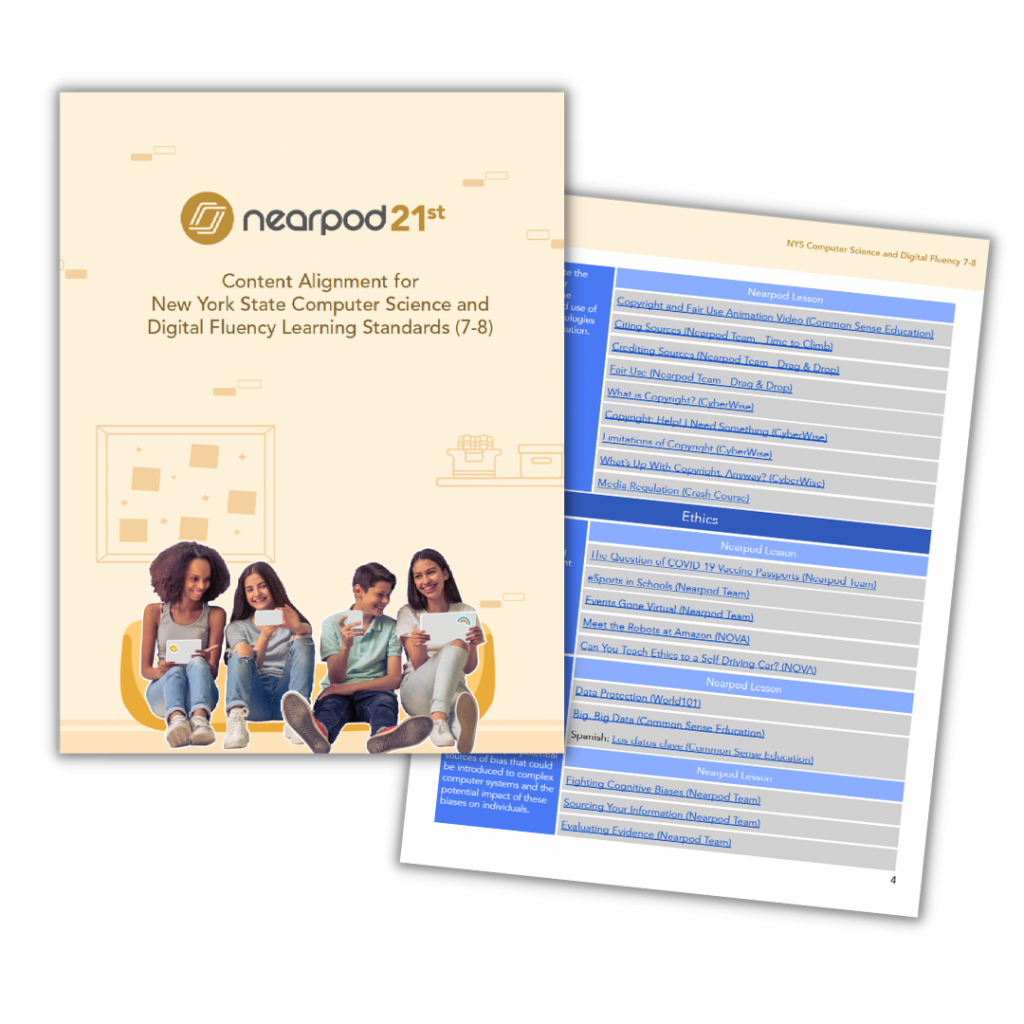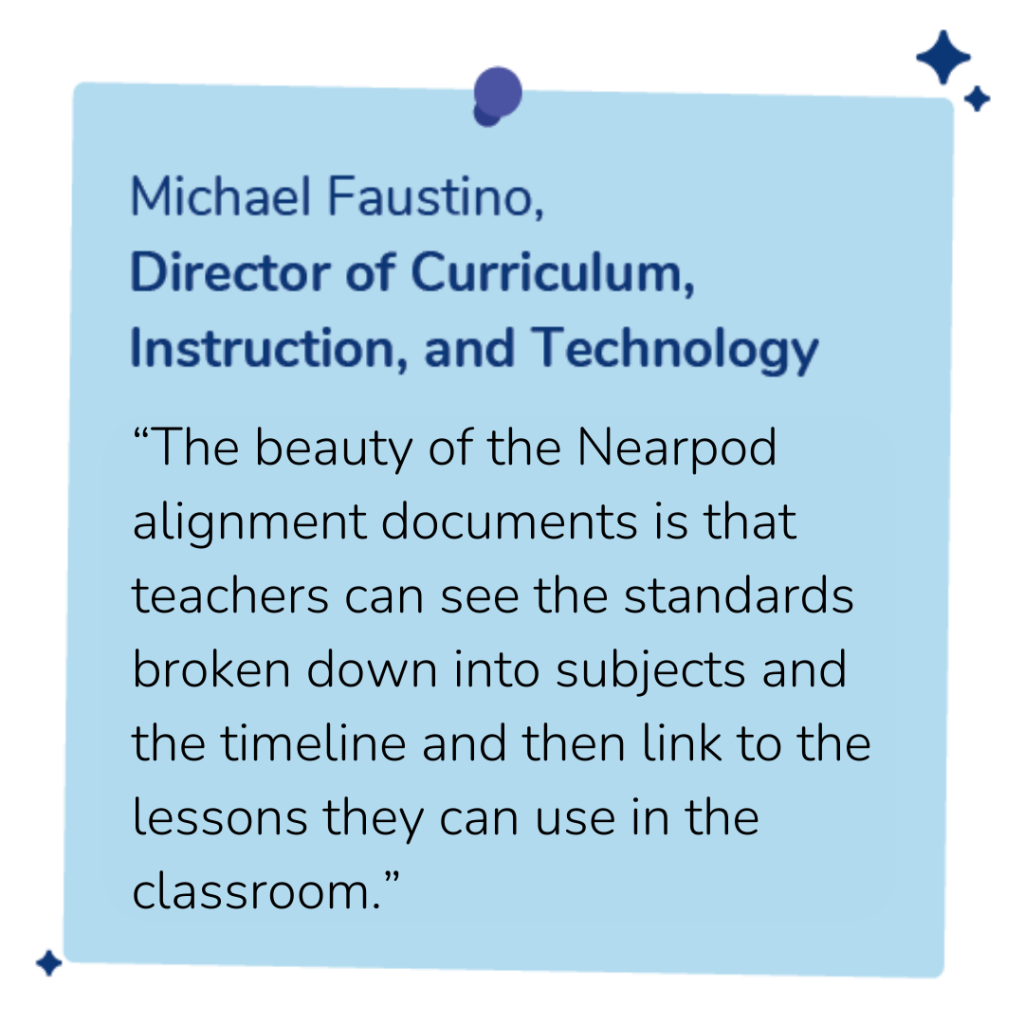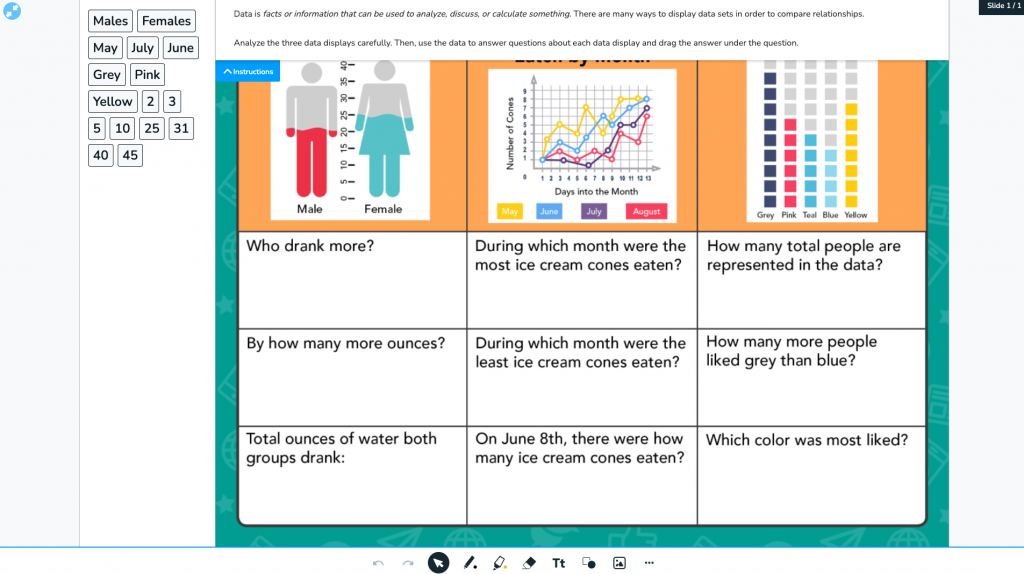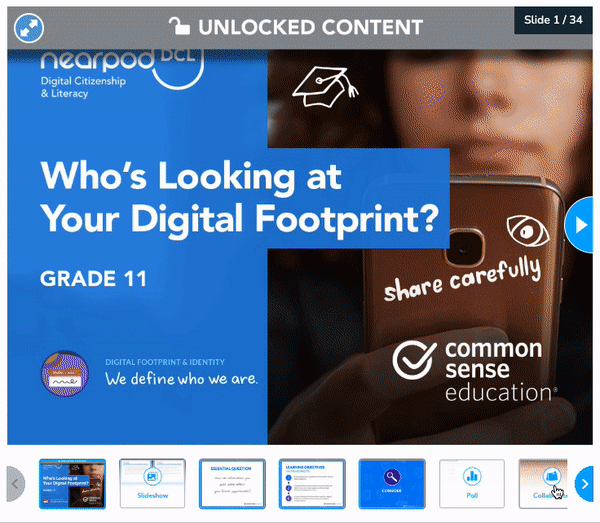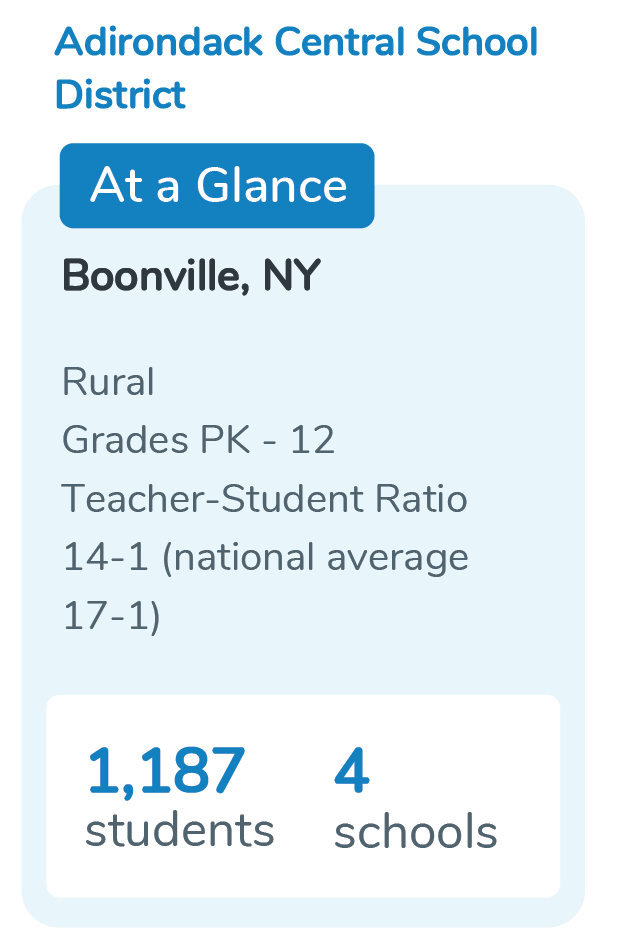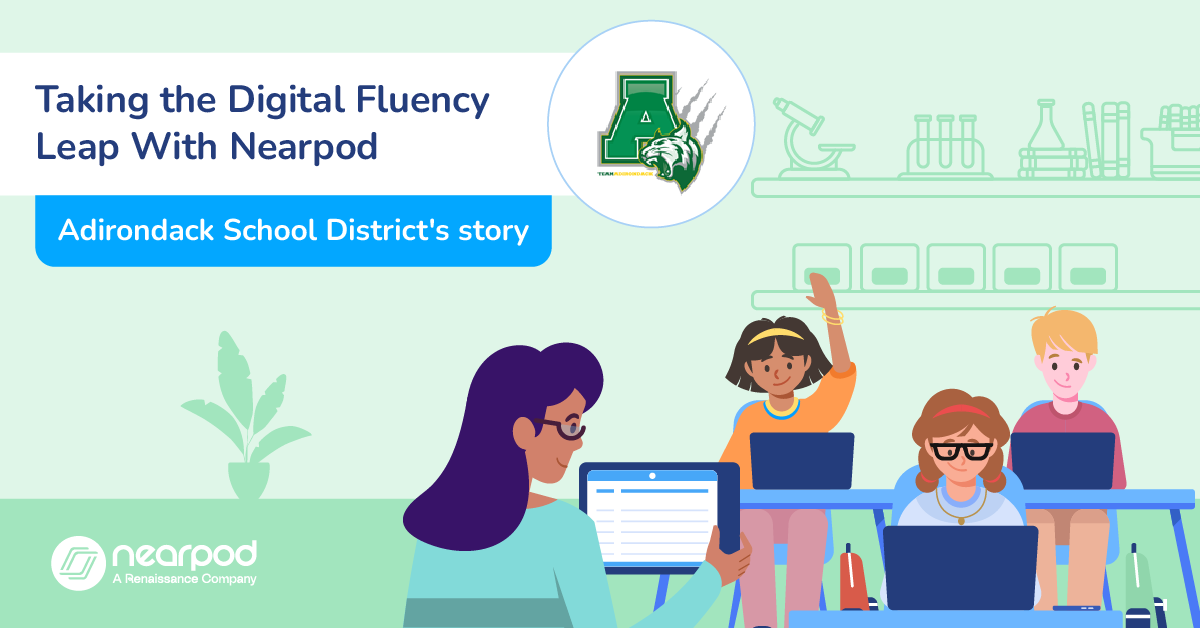
Taking the digital fluency leap with Nearpod: Adirondack Central School District’s story
In a digital age where technological literacy is paramount, the integration of computer science and digital fluency into K-12 education is a top priority for school districts. For students today to become the confident, competitive professionals of tomorrow, they must be prepared for contexts that shift in a click. With this in mind, in 2020, New York State (NYS) introduced Computer Science and Digital Fluency Learning Standards, mandating all K-12 schools to fully incorporate them into their classrooms by the end of 2024. The standards are categorized into five topics: Impacts of Computing, Computational Thinking, Networks and System Design, Cybersecurity, and Digital Literacy.
A significant step for students is a giant leap for educators. Determined to support and not swamp teachers, the Adirondack Central School District in upstate New York is leveraging its long-term partnership with Nearpod to prepare its staff for the standards—and the assessments that will inevitably follow. Together, the district, educators, and Nearpod specialists devised a pioneering plan to align ready-to-teach lessons from Nearpod’s 21st Century Readiness Program with these standards so that by the time they come into force, everyone knows what they’re doing, how they’re doing it, and why.
New to Nearpod? Teachers can sign up for free below to access and create interactive lessons. Administrators can schedule a call with an expert to unlock the full power of Nearpod’s 21st Century Readiness Program for schools and districts.
Main challenge: Navigating digital literacy standards with purpose
How could an ambitious rural public school district prepare all its teachers and students for incoming digital literacy standards without ramping up the pressure and workloads?
Determined teachers across the Adirondack Central School District were aware of the criteria set out by the New York State Education Department. For Michael Faustino, the district’s director of curriculum, instruction, and technology, the only way to successfully implement the standards was to transform educators’ apprehension into intention and purpose.
“The easy way out would be to explain the standards and ask teachers to just do their best. That’s not our philosophy. When you have new standards, there’s going to be an assessment of some sort and there must be an accountability measure,” he explains.
Michael knew the district needed to support all teachers with a solid, structured plan so they didn’t feel overwhelmed or underequipped.
“Anytime you have mandates come down, the tendency is to put more on teachers’ plates without taking anything away. We realized that we can’t put students first if we put teachers last,” he adds.
For Nick Palczak, the district’s STEAM coordinator, it would be crucial to support teachers in leveraging the existing lessons and resources their students enjoyed and engaged with.
“Our educators are already meeting many of the standards—sometimes without even knowing it. So, the question was simple: How do we incorporate these lessons into their classes?” he asks.
The answer was Nearpod. The Adirondack Central School District has been an active Nearpod partner since January 2019. The incoming standards present a prime opportunity to take the partnership to the next level and use Nearpod to align what is being done with what needs to be done. As Michael asserts:
“Our goal for this academic year is to familiarize all our teachers with the alignment documents we are creating. If we roll out the alignment by September 2024, we won’t need implementation. We will just be fine-tuning.”
Nearpod’s 21st Century Readiness Program sets path to meet NYS Computer Science and Digital Fluency Learning Standards
Nearpod’s 21st Century Readiness Program is a powerful tool that equips teachers with a singular solution to infuse 21st-century learning into their daily lessons. This program is designed to bridge the gap, ensuring that students not only excel academically but also develop vital life skills.
Adirondack recognized the transformative potential of this program for educators who aspire to ready their students for the complexities of the 21st century while meeting the stringent requirements of the New York State Computer Science and Digital Fluency Learning Standards.
To support the district in the demanding task of aligning its curriculum with the new standards, the Nearpod team helped build alignment documents using lessons from the 21st Century Readiness Program, specifically customized for these incoming standards. These documents encompass comprehensive, user-friendly, and adaptable resources.
The district’s forward-thinking approach to education is evident in creating curriculum maps that meticulously identify Nearpod lessons aligning with the New York State Computer Science and Digital Fluency Standards across various grade levels. Significantly, most of these curriculum resources are sourced from the 21st Century Readiness Program. This strategic integration ensures that students are exposed to high-quality, standards-aligned content and underscores the district’s commitment to nurturing digital fluency and 21st-century skills among its learners. By leveraging these curriculum maps, educators can effectively use them to pinpoint which of their lessons fulfill the criteria of any given standard and track their progress toward ticking all the boxes.
So that’s what Adirondack did, and the results were rewarding—and relieving—as Michael explains:
“We knew we didn’t want a system that provided standard-aligned lessons but was complex to navigate. Nearpod is so easy to use and works so well. Kids love it. Our students’ mental health is one of our primary concerns, so the platform was a win-win.”
Nick concurs: “It’s not hard to introduce Nearpod to a set of students by day two. They can run lessons at their own pace. Teachers, even those who are tech-wary, lose their fear because they still use tools they’re familiar with, like Google Docs, with Nearpod.”
Teaching with, not at
In anticipation of the 2024 deadline, Michael and Nick are collaborating closely with Nearpod to plan and execute a comprehensive districtwide rollout meticulously. The first step will be training administrators to become instructional leaders who build capacity through workshops and ongoing support from turnkey trainers. They aim to help teachers explore the standards and connect the dots to what they’re already teaching.
“We’re not going to teach at them,” Michael insists. “The beauty of the Nearpod alignment documents is that teachers can see the standards broken down into subjects and the timeline and then link to the lessons they can use in the classroom.”
New York State’s learning standards work by bands. Nick has taken each band and broken it down by grade for K-12. He is progressively feeding the alignment documents in which the standards are listed, with an explanation of the standard, examples of the standard that the state provided, and lessons that align with that standard to give to teachers, encouraging them to add their own lessons to the document.
The aim is for teachers to recognize what they’re doing in class and understand how the district and Nearpod can help them fill in the gaps or try something new. Nick gives an example:
“Part of the digital fluency standards is creating a digital artifact. Every teacher who creates a slide in Google Slides is creating digital artifacts. How can we make that more intentional? Why did you pick Google instead of something else? What are the features of it? How do you save it? Do you have folders? Is it stored in the Cloud? What does that mean? Great. Now you can deliver a lesson on digital citizenship.”
Here are some examples of the lessons* Adirondack used for instruction:
- Computer Vocabulary (Grades 2-3): In this 3-5 Nearpod Digital Citizenship and Literacy lesson, students investigate how technology can be used to make their lives simpler, more productive, and more expansive. Students learn the uses of different computer hardware devices.
- Visualizing Data (Grades 4-6): In this 3-5 Digital Citizenship and Technology Drag & Drop activity, students will demonstrate an understanding of how to read various simple data sets.
- Lesson 5: In the Loop (Grades 7-8): In this 3-8 Coding lesson, students will be able to define what a loop is and explain its importance as it relates to writing code. Students will practice their new skills by completing a selection of CodeMonkey challenges.
- Who’s Looking at Your Digital Footprint? (Grades 9-12): In this Common Sense Education lesson on Digital Citizenship, students learn how any information they post online can affect their future. They create a vignette that shows how a positive digital footprint can help take advantage of opportunities.
*These lessons are only available on Nearpod’s 21st Century Readiness Program.
From vision to action
For Adirondack, the key to successfully implementing the standards is to know which skills to teach and how. Even if students nor teachers know what the future holds in store, as Nick concludes:
“We want our kids to leave Adirondack ready for high tech colleges and high tech jobs. I had a student who graduated last year. He’s now at the Rochester Institute of Technology (RIT). He’s trying to decide which robotics club he is going to join so he can compete in robotics programs. He’s so excited to go to a technical college when he grew up in a town of 100 people. I want more and more students to be able to leave our school to do those kinds of things.”
Michael believes that educators must understand what is being measured and the outcomes:
“It’s not enough for us to have a vision statement that says we want our students to be college and career ready. We’re preparing them for jobs that don’t even exist right now. We can’t just give them taglines; we need to give them avenues, and the only way is by building professional learning without overwhelming teachers. That’s where Nearpod makes all the difference.”
It seems like the difference is already being made in the district. Far from dreading the incoming standards, Nick is confident they will help Adirondack achieve its goals:
“In 2024, we want to intentionally meet these standards because we know why they are in place. We want to ensure our staff knows why these standards are in place. What jobs are available in 20 years? I have no idea. What skills do you need to be ready for those jobs? Adirondack’s goal is to have kids college and career ready. These standards are really going to help us to meet that goal.”
To learn about the Adirondack Central School district’s actions, watch the webinar “Preparing for Digital Fluency with Nearpod” where they explain how they’ve been using Nearpod resources!
Take the digital fluency leap with Nearpod
Nearpod created New York State-centric alignment documents to demonstrate to teachers how their existing lessons correspond with incoming standards and help the district implement a strategic plan to meet them well before the 2024 deadline. Adirondack squared up to the challenge and developed curriculum maps, which clearly outlined the standards for each grade level and identified relevant Nearpod lessons that taught the necessary skills for students in each grade band.
By offering comprehensive, standards-aligned lesson plans, interactive activities, and assessment tools, the program simplified the process for educators and ensured that students receive a dynamic and engaging learning experience. It sets a blueprint to help schools across and beyond the state take bold strides and implement new educational standards with confidence, calm, and care.
Ready to learn more about how to prepare every student for success with Nearpod’s 21st Century Readiness Program? Schedule a call with one of our experts and learn how you can empower educators with unlimited access to everything they need to engage learners.
About the district
The Adirondack Central School District in Boonville, NY, is a rural public school district encompassing four schools—two elementary, a middle school, and a high school. The district strives to create a safe, respectful, and accepting environment, and to provide students with the mental and emotional support to thrive and excel. By prioritizing open and transparent communication, and fostering a positive school spirit, Adirondack is committed to uniting the community while nurturing academic growth and achievement. Firmly focused on developing STEAM capacity, the district has invested greatly in building facilities and capacity to prepare students for whatever might await them. Its administrators and educators work for and with students to raise graduation rates, enhance state exam performance, minimize the need for academic intervention services, and increase enrollment in advanced courses to prepare students for their chosen—and changing—life endeavors.
About the educators
Michael Faustino, with three decades of experience in education, including 17 years as a kindergarten teacher before becoming a principal, now serves as the director of curriculum, instruction, and technology for the Adirondack Central School District. He leads the district’s mission to prepare all students for college and career success by emphasizing the importance of curricula and data. Michael collaborates closely with educators throughout the district to ensure they are well prepared to implement the New York State Computer Science and Digital Fluency Learning Standards in 2024, guiding teachers and students through every step of the transition, aligning with and even surpassing the timeline.
Nick Palczak, a seasoned physics teacher at Adirondack Central School since 1996, also serves as the district’s STEAM coordinator. He collaborates closely with the tech director to oversee K-12 STEAM programs, while also teaching STEAM courses at middle and high schools. In 2021, Nick played a pivotal role in establishing the Adirondack STEAM program, including setting up a new laboratory post COVID-19. In the past two-plus years, the Adirondack STEAM program has won several robotics competitions and has received numerous recognitions for its work with students. Alongside district coordinator Michael Faustino, Nick readies students and educators for upcoming standards while integrating STEAM into the curriculum. With a family legacy in education, Nick is passionate about preparing students and their teachers for 21st-century careers.

Nearpod’s award-winning platform is used by thousands of schools around the globe, transforming classroom engagement.

